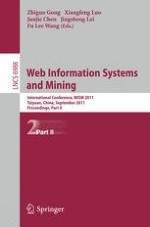The two-volume set LNCS 6987 and 6988 constitutes the refereed proceedings of the International Conference on Web Information Systems and Mining, WISM 2011, held in Taiyuan, China, in September 2011. The 112 revised full papers presented were carefully reviewed and selected from 472 submissions. The second volume includes 56 papers organized in the following topical sections: management information systems; semantic Web and ontologies; Web content mining; Web information classification; Web information extraction; Web intelligence; Web interfaces and applications; Web services and e-learning; and XML and semi-structured data.
